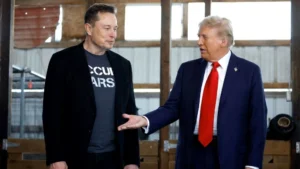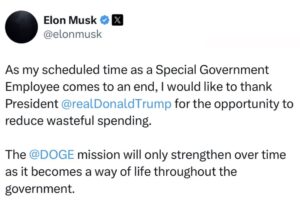In a move that has sent ripples through political and business circles alike, Elon Musk, the billionaire entrepreneur and CEO of Tesla and SpaceX, has announced his departure from the administration of President Donald Trump. This decision, made public on May 28, 2025, marks the end of Musk’s brief but tumultuous tenure as a Special Government Employee tasked with leading the Department of Government Efficiency (DOGE). His exit, which comes just days before the expiration of his 130-day term, has sparked intense speculation about the reasons behind it, the future of DOGE, and what this means for Musk’s legacy in both the political and corporate arenas.
Musk’s involvement in the Trump administration began with high expectations and bold promises. Appointed in January 2025, shortly after Trump’s inauguration for his second term, Musk was tasked with spearheading DOGE, a newly created entity aimed at streamlining federal operations and slashing government spending. The initiative, named with a nod to Musk’s favored cryptocurrency Dogecoin, was ambitious from the start. Musk pledged to cut at least $1 trillion from the federal budget, a goal that aligned with Trump’s campaign promises to reduce government waste and inefficiency. DOGE’s mission was to scrutinize federal agencies, eliminate redundant programs, and reduce the civilian workforce, all while promoting a culture of fiscal responsibility.
The early days of Musk’s tenure were marked by frenetic activity and high visibility. Known for his unorthodox approach and relentless work ethic, Musk brought his signature intensity to Washington. He was often seen at the White House, sometimes donning a campaign-style hat, and used his social media platform X to broadcast DOGE’s progress and rally public support. His team sent emails to millions of federal employees, offering buyouts for early retirement or resignation, and implemented weekly performance reporting to identify underperforming staff. These measures led to significant reductions, with approximately 260,000 federal jobs—about 12% of the civilian workforce—eliminated through layoffs, retirements, and contract buyouts.
However, Musk’s aggressive tactics quickly drew criticism. Federal employee unions decried the layoffs as draconian, arguing that they disrupted essential services. Protests erupted outside Tesla showrooms, with some demonstrators vandalizing vehicles in retaliation for Musk’s policies. Legal challenges mounted, with several lawsuits alleging that DOGE’s actions violated federal labor laws. Critics also questioned Musk’s qualifications for such a role, pointing out that his experience as a tech mogul did not necessarily translate to navigating the complexities of government bureaucracy. The backlash was compounded by Musk’s public persona, which, while charismatic to some, alienated others who viewed his involvement as an overreach by a private citizen in public affairs.

Tensions within the administration also began to surface. Reports of clashes between Musk and senior officials, including Secretary of State Marco Rubio and Transportation Secretary Sean Duffy, highlighted disagreements over the scope and pace of DOGE’s reforms. Musk’s outspoken criticism of a key legislative proposal further strained his relationship with Trump. Just one day before his departure announcement, Musk publicly expressed disappointment with a major budget and tax bill championed by Trump, describing it as a “massive spending bill” that undermined DOGE’s efforts to reduce the federal deficit. The bill, which extended tax cuts from Trump’s first term and allocated funds for projects like border wall construction, was projected to increase the deficit by nearly $4 trillion over a decade. Musk’s comments, aired during an interview with CBS News, were seen by some as a direct challenge to Trump’s agenda.
The timing of Musk’s exit, coupled with his lack of a formal farewell or direct communication with Trump, has fueled speculation about a rift between the two men. Once described as close allies—Musk was a major financial backer of Trump’s 2024 campaign, contributing over $250 million—their relationship appears to have cooled. Some analysts suggest that Musk’s departure was inevitable, given the constraints of his role as a Special Government Employee, which limited his service to 130 days per year under federal law. Others argue that the decision was driven by Musk’s frustration with bureaucratic resistance and his desire to refocus on his businesses, particularly Tesla, which has faced declining demand amid his political activities.
Despite the controversies, Musk’s tenure at DOGE achieved measurable results. The department reported cutting approximately $175 billion in federal spending, a significant figure though far short of the $1 trillion goal. Initiatives like consolidating redundant programs and renegotiating government contracts were hailed as steps toward greater efficiency. Musk himself emphasized that DOGE’s mission would endure, stating on X that it would “become a way of life throughout the government.” The White House echoed this sentiment, affirming that the department’s work would continue under new leadership, though no successor has been named.
Musk’s departure raises broader questions about the intersection of business and politics. His involvement in the Trump administration was a high-profile experiment in bringing private-sector expertise to government, but it also exposed the challenges of such a crossover. Musk’s wealth, influence, and unconventional style made him a polarizing figure, capable of driving change but also attracting scrutiny. His exit may signal a shift in his priorities, with Musk indicating a desire to reduce his political involvement and focus on his companies. Tesla, in particular, faces challenges from competitors and shifting consumer preferences, while SpaceX continues to push boundaries in space exploration.
For the Trump administration, Musk’s departure is both a loss and an opportunity. DOGE’s aggressive cost-cutting aligned with Trump’s fiscal conservatism, but its execution stirred unrest that could complicate future reforms. The administration now faces the task of sustaining DOGE’s momentum without Musk’s star power and polarizing presence. Meanwhile, the public and investors are watching closely to see how Musk’s next chapter unfolds. Will he double down on innovation at Tesla and SpaceX, or will his flirtation with politics leave a lasting mark on his legacy?

The broader implications of Musk’s exit extend beyond Washington. His brief tenure highlighted the potential and pitfalls of outsider influence in government. Supporters argue that figures like Musk bring fresh perspectives and urgency to entrenched systems, while critics warn of the risks of unchecked power and conflicts of interest. As the nation grapples with economic challenges and political polarization, Musk’s departure serves as a case study in the delicate balance between disruption and stability.
Looking ahead, Musk’s influence is unlikely to wane. His platform X remains a powerful tool for shaping public discourse, and his wealth and innovation continue to command global attention. Whether he retreats fully from politics or reengages on his own terms, Musk’s actions will remain a focal point for observers. For now, his exit from the Trump administration closes a chapter marked by ambition, controversy, and unfinished business, leaving the future of DOGE—and Musk’s role in the public sphere—open to speculation.
In conclusion, Elon Musk’s announcement to leave the Trump administration is more than a personnel change; it’s a moment that encapsulates the complexities of his persona and the challenges of reforming government. From bold promises to public disputes, his tenure at DOGE was a whirlwind that achieved results but fell short of its loftiest goals. As Musk returns to his corporate empire, the world watches to see what this enigmatic figure will do next, and whether his brief foray into politics will redefine his legacy or merely be a footnote in his storied career.